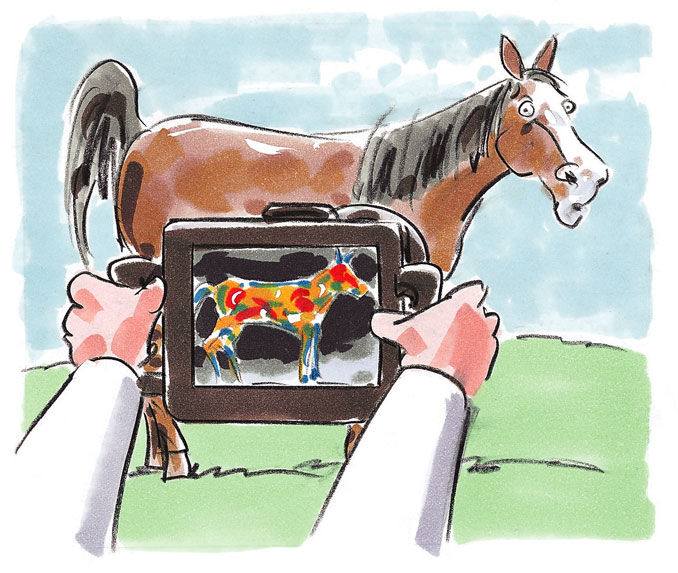|
indicate problems, yet a fetlock that is extremely
different in temperature from the others is not only an
indicator of a problem but may actually point to problems
that have not yet developed into full scale medical issues
but may be well on their way, such as beginning arthritis
that is not yet pronounced enough to be picked up with other
diagnostic tools.
 This is especially significant if an exam conducted at a
later date shows that there is still some residual heat
emanating from a previously affected site. At this point the
use of radiography may be indicated and those finding, when
combined with the thermographic exam, could very well lead
to the earliest possible detection of arthritic pain, the
animalís attempting to compensate for it, and the resulting
lameness in another limb as the effect of this procedure.
This not only helps to treat the limb that is actually
affected by a problem, but also prevents the sometime
lameness of the animal to continue. This is especially significant if an exam conducted at a
later date shows that there is still some residual heat
emanating from a previously affected site. At this point the
use of radiography may be indicated and those finding, when
combined with the thermographic exam, could very well lead
to the earliest possible detection of arthritic pain, the
animalís attempting to compensate for it, and the resulting
lameness in another limb as the effect of this procedure.
This not only helps to treat the limb that is actually
affected by a problem, but also prevents the sometime
lameness of the animal to continue.
Thermography is also a great tool when all other exams
come back negative but you still have the gut feel that
something is not quite right with your horse. If you are a
trainer you probably have a much better relationship with
your horse than anyone else, and you can tell if movements
are suddenly off by even a fraction! If, for example, your
horse suddenly is not able to move its neck as far to the
right as it did before, a veterinary exam may not reveal
anything amiss, yet with a thermographic camera the
veterinarian may notice a definite change in pattern along
the right side of the neck, perhaps specifically alongside
the fourth cervical vertebra. Perhaps there is a lack of
temperature rather than an increase and everything points to
a pinched nerve root. A follow-up examination via the
ultrasound will quite possibly show that there is a lump of
tissue that may have been a remnant of a past trauma which
is now once again affecting the animal. Treatment may be
conducted with the help of an anti-inflammatory that is
administered into the lump.
These examples prove that thermography is a useful tool
in equine diagnosis and treatment. While it is true that
this camera has been available for a while, it is only
recently that applications have bee developed to adequately
employ it in the veterinary practice. A veterinarian will
need to learn how to read the camera results, yet with a bit
of practice this is easy to accomplish. Following the
principle that every animate object radiates heat,
thermography allows you to see exactly how much heat is
emitted by a horse at any given moment. Infrared detection
measures the heat and the video image translates this result
into a picture that may be interpreted for the sake of
treatment. In days gone by the equipment needed was unwieldy
and hard to use, yet the consistent modernization has
resulted in the creation of cameras that are small,
hand-held, and very easy to operate.
You may remember the 1996 Atlanta Olympics which were the
point in time when thermography entered the mainstream of
sports medicine. Problems with tendons and ligaments are
easily diagnosed with this non-invasive tool, and the
tell-tale signs of inflammation and tissue damage may be
diagnosed a lot sooner than with conventional methods.
Farriers are also joining the ranks of professionals who
realize the many advantages thermography is offering. Hoof
problems and hoof changes can be diagnosed with the help of
thermography, thus helping the farrier to realize the early
formation of a deep abscess, laminitis, and also wall
bruises that require specialized shoeing.
As you can see, there are a plethora of applications for
this diagnostic tool, and it does not matter if you are
looking to investigate potential problems with your horseís
back to evaluate a poor saddle fit, or if you are looking to
take a look at the effectiveness of leg wraps and
hydrotherapy to affected limbs, thermography will be a
useful tool for the properly trained veterinarian who learns
how to use it in accordance with the specifications of the
machine.

|